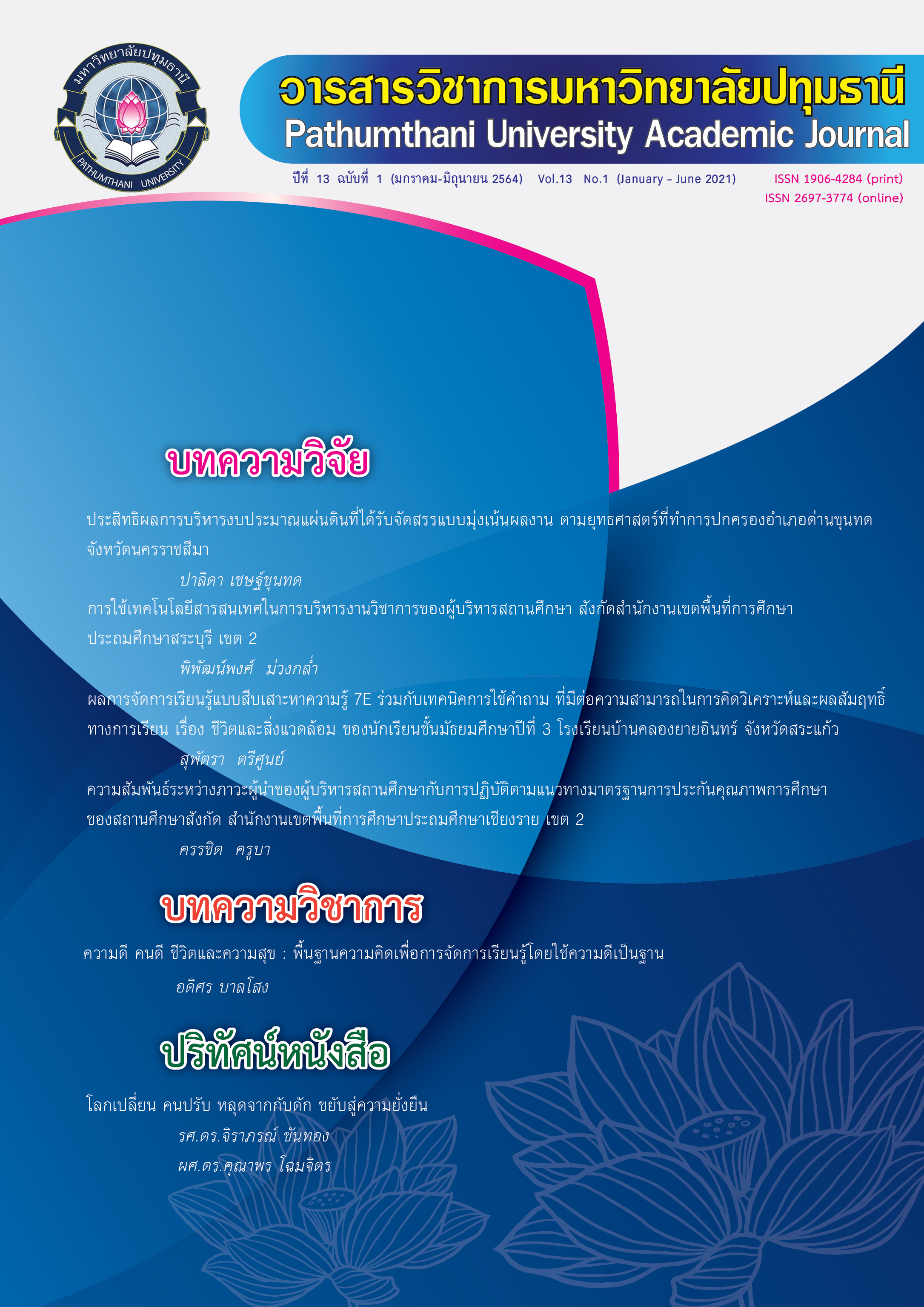SOCIAL MEDIA USAGE BEHAVIOR AND RESULT OF TAMARIND PRODUCT TRADERS IN MUANG PHETCHABUN DISTRICT, PHETCHABUN PROVINCE
Keywords:
Behavior, Social Media, Tamarind ProductsAbstract
The objective of this study was to research social media usage behavior and its result of tamarind product traders in Muang Phetchabun district, Phetchabun province. This study is a quantitative study, the survey data was collected by questionnaires. The research samples are 165 tamarind product traders in Muang Phetchabun district, Phetchabun province. The statistics used in basic data analysis are frequency value, percentage value, average value, standard deviation and Chi-Square for hypothesis testing. The study results were as follows: Most of the samples were female, aged between 51-60 years, educated in junior high school level, with 20,001 - 30,000 Baht per month income, and with 11-15 years of tamarind product selling duration. The most sold tamarind products are sweet tamarind products. They have 1-5 years of social media using experience. They use Facebook as a social media for tamarind product selling, via cell phones, 3-4 times per a day, between 12.00 - 18.00 o’clock. The study results showed that the overall usage of social media for tamarind product selling is at high level. The tamarind product traders use it to send tamarind product information to clients directly, conveniently and fastest, with an average value of 4.75. Secondly, it saves the cost of tamarind product selling and reduces client contact time, with an average value of 4.57. Thirdly, it helps the tamarind product traders collect the information of the clients effectively, with the lowest average value of 4.01. The comparison result of general informations and social media usage behavior of tamarind product traders in Muang Phetchabun district, Phetchabun province in order to test the hypothesis showed that different gender, age, education level and income cause different social media usage behaviors with statistical significance at .001 level, which is based on the hypothesis.
References
กายกาญจน์ เสนแก้ว. (2560). พฤติกรรมการใช้เครือข่ายสังคมออนไลน์ของวัยรุ่นในประเทศไทย. วิทยานิพนธ์ปริญญาศิลปศาสตรมหาบัณฑิต. มหาวิทยาลัยธรรมศาสตร์.
ชนิษฏา กลีบยี่สุ่น. (2561). พฤติกรรมการใช้สื่อออนไลน์ในการเข้าถึงข้อมูลด้านศัลยกรรมความงามของผู้บริโภค. การค้นคว้าอิสระปริญญาบริหารธุรกิจมหาบัณฑิต. มหาวิทยาลัยธรรมศาสตร์.
ณัฐวรรณ จุลกัลป์ ธิดารัตน์ ลาดบูรณ์ และเลอลักษณ์ บุญล้ำ. (2562). “สื่อสังคมออนไลน์ที่มีผลต่อการตัดสินใจซื้อผลิตภัณฑ์ของผู้บริโภค”. The 11th National Conference on Information Technology (NCIT2019). ณ สถาบันเทคโนโลยีไทย-ญี่ปุ่น.
บุญชม ศรีสะอาด. (2556). วิธีการทางสถิติสำหรับการวิจัย. กรุงเทพมหานคร : สุวีริยาสาส์น.
วนัสนันท์ สังสหชาติ. (2556). สื่อโฆษณาใน Facebook ที่มีผลต่อกระบวนการตอบสนองของผู้บริโภค. การค้นคว้าอิสระปริญญานิเทศศาสตรมหาบัณฑิต. มหาวิทยาลัยขอนแก่น.
อุไรรัตน์ มากไมตรี. (2558). อิทธิพลของสื่อออนไลน์ที่มีผลต่อพฤติกรรมผู้บริโภค กรณีศึกษาธุรกิจเบเกอรี่ ในเขตกรุงเทพมหานคร. วิทยานิพนธ์ปริญญาวารสารศาสตรมหาบัณฑิต. มหาวิทยาลัยธรรมศาสตร์.
เอมิกา เหมมินทร์. (2556). พฤติกรรมการใช้และความคิดเห็นเกี่ยวกับผลที่ได้จากการใช้เครือข่ายสังคมออนไลน์. วิทยานิพนธ์ปริญญามหาบัณฑิต. สถาบันบัณฑิตพัฒนบริหารศาสตร์.
ไอรินทร์ โชติอัครอนันต์. (2558). ปัจจัยด้านการโฆษณาผ่านสื่อออนไลน์ต่อการซื้อเครื่องสำอางของสาขาวิทยาศาสตร์เครื่องสำอาง. สารนิพนธ์ปริญญาบริหารธุรกิจมหาบัณฑิต. มหาวิทยาลัยแม่ฟ้าหลวง.
Likert, R. A. (1932). Technique for the Measurement of Attituude. Archives Psycholgical. Vol. 3 No. 1. pp 42-48.
Downloads
Published
How to Cite
Issue
Section
License
บทความที่ได้รับการตีพิมพ์เป็นลิขสิทธิ์ของวารสารมหาวิทยาลัยปทุมธานี
ข้อความที่ปรากฎในบทความแต่ละเรื่อง เป็นความคิดเห็นส่วนตัวของผู้เขียน กองบรรณาธิการไม่จำเป็นต้องเห็นด้วยเสมอไป และไม่มีส่วนรับผิดชอบใด ๆ ถือเป็นความรับผิดชอบของผู้เขียนแต่เพียงผู้เดียว



